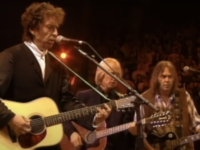Even after a damaging season of loss, Neil Young remained, as always, restless and relentless – imbuing the modernistic, reverb-soaked Le Noise with a kind of anti-melancholy. He hadn’t stopped searching for light in the darkness and, even at this late date, somehow never sounded quite the same from album to album.
Released on Sept. 28, 2010, Le Noise found Young partnering with producer Daniel Lanois (Peter Gabriel, the Neville Brothers, Emmylou Harris, Bob Dylan, Willie Nelson, U2), recording alone with his guitar in an atmosphere that sounds nothing like the typical unplugged session. Lanois, having taken his Acadian-influenced hippie-voodoo vibe from New Orleans to the uber-cool Silverlake area of Los Angeles, didn’t hand Young any old instrument: He’d been working on a specially designed hollow-body Gretsch electric contraption.
Lanois then processed and tweaked the stripped-down sessions to give them sonics that were loud and layered, but also haunted and honest – something that’s instantly old-timey, brilliant and new. There was no Stills, no Crosby or Nash and no Crazy Horse. Instead, the textured, live-sounding Le Noise found a place in between Neil Young’s acoustic work and his more muscular full-band rock music.
That’s where this left turn differed from previous vanity projects like 1982 synthesizer/vocoder oddity Trans, 1985’s cornpone Old Ways or even 1991’s hurricane of feedback Arc/Weld. Alone in these kind of spooky surroundings (the duo, it’s said, only recorded on nights when there was a full moon), Young could hear himself think again – even if the questions, in the end, weren’t all that much different from his days with Buffalo Springfield during the Vietnam War era.
He admitted that the songs, then as now, were mostly about love and war. And for that, he made no excuses. After all, Young seemed to surmise, what unites us more often – in protest, or else in prayer?
Ours is still an angry world, and his song of the same title included this imitative loop recalling both the hopes and fears that we all carry. There’s not much solace, though: “Some see life as hope eternal; some see life as a business plan,” Young sang. Unable to find answers from without, Young perhaps inevitably turned within – examining his own restless individuality. Again, he wasn’t compelled to over explain: “Said a lot of things I can’t take back,” Young reminded, “and I don’t know if I want to.”
Still, this tough-minded introspection led back to other familiar places: “Sign of Love” boasted more than a passing resemblance to “Cinnamon Girl” – one of the more recognizable tunes recorded with Neil Young’s old California garage-band buddies in Crazy Horse. Here, Young talked about how relationships can nurture us through pain: “We both have silver hair, and a little less time, but there are still roses on the vine.”
“Hitchhiker,” sounding like something written in the narcotic 1970s, had been banging around since at least the 1992 tour in support of Harvest Moon – though it only just then saw official release. “Love and War” also strongly recalls “Hey, Hey, My, My.” “I’ve tried to leave my past behind,” the always willful, though a little less contrary Neil Young admitted at one point, “but it’s catching up with me.”
Then “Peaceful Valley Boulevard” went even further back, implicitly exploring the symmetry – and the cost – found between today’s policy initiatives and this country’s brutal sense of manifest destiny in the old American West. In so doing, Neil Young connected with a new generation’s heightened sense of responsibility: “Who will be the one to lead this world?” he sang. “Who’ll be the one to protect God’s creation?”
Le Noise, however, didn’t immediately achieve these vistas. In fact, the opener “Walk With Me” at first seemed like a rudimentary invitation to begin a relationship’s journey, just another nostalgic paean to love. But it eventually dissolved into a bright dissonance of feedback, tape-loops and the first of several echoing revelations about sacrifice and longevity.
Young had recently endured the passing of a pair of important collaborators, filmmaker Larry “L.A.” Johnson (a key figure in Young’s then-newly launched career-spanning outtakes project) and multi-instrumentalist / producer Ben Keith. It was a concurrent absence that Young initially estimated would render as much as 70 percent of his full-band repertoire forever changed. “I lost some people I was traveling with,” Young sang. “I miss the soul and the old friendship.”
He was moved to reassure those who have seen less in “Someone’s Gonna Rescue You,” and later rejoins an ongoing quest for redemption in earnest during the closing “Rumblin.'” Through it all, Neil Young seemed to sensing a seismic shift overtaking us – “Can’t you feel a new wind blowing? Don’t you recognize that sound?” – but is just as certain that lasting change comes not from programs or politicians, but from within.
“When will I learn how to listen?” Young sang. “When will I learn how to feel? When will I learn how to give back? When will I learn how to heal?” In this way, this wandering spirit shared a lasting hopefulness on Le Noise: Hope that he could fight through loss to find a deeper appreciation for what remains, that he could better understand himself and this world, that he could still help lead the way.
Even if it takes some time to get there, for Neil Young – and for us.
- The Bright Spots in George Harrison’s Troubled ‘Dark Horse’ Era - December 29, 2024
- The Pink Floyd Deep Cut That Perfectly Encapsulates ‘The Wall’ - November 29, 2024
- Why Pink Floyd’s ‘The Endless River’ Provided a Perfect Ending - November 11, 2024



